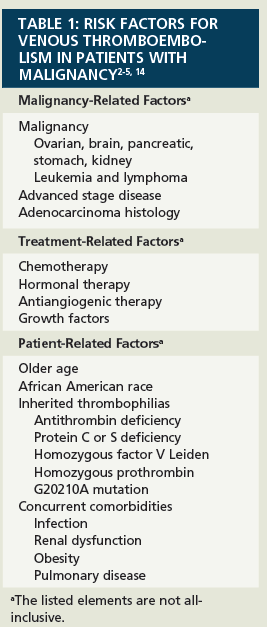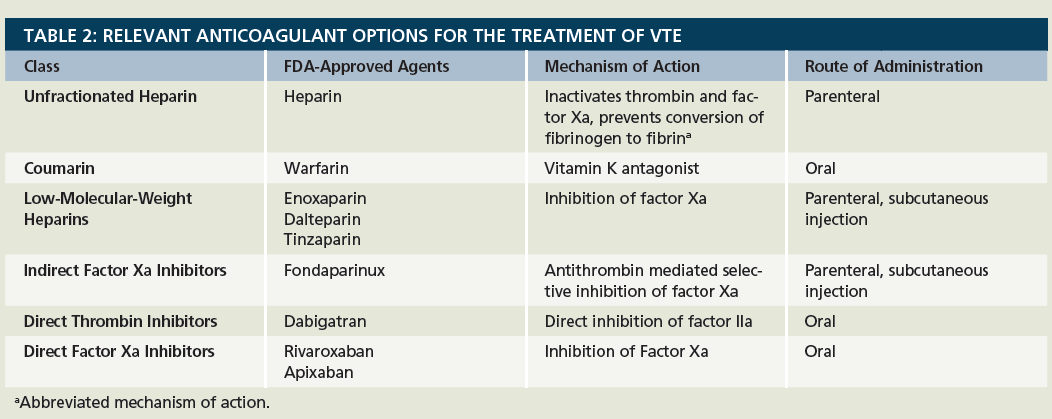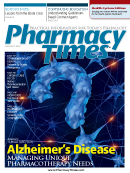Publication
Article
Pharmacy Practice in Focus: Health Systems
Venous Thromboembolism and Cancer: Multiple Treatment Agents
Author(s):
Introduction
Venous thromboembolism (VTE) is defined as the occurrence of deep vein thrombosis (DVT), pulmonary embolism (PE), or both. The disease process and level of risk are different for patients affected by cancer when compared with other patient populations, which has resulted in specific recommendations for both treatment and prophylaxis. There are several guidelines regarding VTE in patients with cancer, which include but are not limited to those published by the American Society of Clinical Oncology and the American College of Chest Physicians (ACCP).

The relationship between VTE and cancer was first described in the 19th century by physician Armand Trousseau, and it was later recognized that venous thrombosis in cancer is related to hypercoagulability.1 The risk for VTE is elevated up to 7-fold in patients with malignancy.1 There are several characteristics that increase this risk in patients with cancer (Table 1). VTE is the second most common cause of mortality in patients with malignancy, and this patient population has a 3-fold higher risk of recurrent thromboembolism and death from any cause when compared with those with VTE who do not have cancer.1,2 This highlights the unique importance of VTE management in patients with malignancy.
Pathogenesis
Malignancy affects the coagulation cascade in various ways. In addition to chemotherapy itself, the interaction of cancer cells with monocytes or macrophages results in the release of tumor necrosis factor, interleukin-1, and interleukin-6, all of which contribute to direct damage to the endothelium on the inner surfaces of blood vessels.3 Further consequences of tumor cell interactions with macrophages include activation of platelets, factor XII, and factor X, which ultimately results in thrombin formation and, thus, increased risk of thrombosis.3 Cancer cells produce procoagulant substances such as cancer procoagulant and tissue factor.3,4 These procoagulants and tissue factors result in direct activation of factors X and VII, respectively.3 It has been shown that tissue factor expression is related to mutations in KRAS and TP53 genes.4 Malignant cells express the prothrombotic plasminogen activator inhibitor-1, which inhibits fibrinolysis.4 Adenocarcinomas release mucins, which have sialic acid moieties and are the source of nonenzymatic activation of factor X.3 Furthermore, mucins also interact with platelets via platelet P-selectin and cause platelet aggregation in the absence of thrombin generation.4 The administration of chemotherapy can result in increased expression of tissue factor, von Willebrand factor, and factor VIII, in addition to decreased levels of antithrombin as well as proteins C and S.4
VTE Treatment in Cancer
Multiple agents are available to treat VTE in cancer patients (Table 2). Based on the literature available, low molecular weight heparins (LMWHs) are preferred over unfractionated heparin (UFH) for the initial 5 to 10 days of therapy for VTE in cancer (Online Table 3).5 Additionally, LMWHs are preferred over vitamin K antagonists (VKAs) for a duration of at least 6 months, whereas longer durations of anticoagulation may be considered in certain patients with persistent risk factors including active cancer (Online Table 4).5

Table 3: Agents Used for the Initial Treatment of VTE in Cancer5
Anticoagulant
Dose
UFH
80 units/kg IV bolus, then 18 units/kg/h IV, then adjusted based on aPTT
Dalteparin
100 units/kg SC once every 12 hours
200 units/kg SC once daily
Enoxaparin
1 mg/kg SC once every 12 hours
1.5 mg/kg SC once daily
Tinzaparin
175 units/kg SC once daily
Fondaparinux
<50 kg: 5 mg SC daily
50-100 kg: 7.5 mg SC daily
>100 kg: 10 mg SC daily
aPTT = activated partial thromboplastin time; IV = intravenous; SC = subcutaneous.
Table 4: Agents Used for Long-Term Treatment of VTE in Cancer5
Anticoagulant
Dose
Dalteparin
200 units/kg SC once daily for 1 month followed by 150 units/kg once daily
Enoxaparin
1.5 mg/kg SC once daily
1 mg/kg SC every 12 hours
Tinzaparin
175 units/kg SC once daily
Warfarin
Titration of oral dosing to achieve target INR 2-3 with concurrent heparin or LMWH bridge
SC = subcutaneous.
For the initial choice of agent for anticoagulation in cancer patients diagnosed with a VTE, there is limited highquality evidence available. A Cochrane analysis performed in 2011 included 16 randomized controlled trials (RCTs) evaluating parenteral anticoagulation use in the first 5 to 10 days after VTE diagnosis, with cancer patients analyzed as a subgroup.6 The review reported a statistically significant mortality reduction with the use of LMWHs versus unfractionated heparin (RR 0.71; 95% CI, 0.52-0.98).6 No statistically significant differences were observed between fondaparinux versus UFH or dalteparin versus tinzaparin; additionally, no differences were observed regarding the recurrence of VTE.6
The strategy for long-term anticoagulation in cancer patients is more established with the current body of literature favoring the use of LMWHs over oral VKAs. Another Cochrane review published in 2014 examined LMWHs versus oral VKAs and included 10 RCTs.7 The analysis showed no difference in survival (HR 0.96; 95% CI, 0.81-1.14), but the recurrent VTE time to event analysis favored LMWHs (HR 0.47; 95% CI, 0.32-0.71).7 The only LMWH agent with FDA approval for extended therapy to prevent recurrent thromboses in patients with malignancy is dalteparin, which in large part resulted from evidence provided by the CLOT trial.5
The CLOT trial was a randomized, open-label, international, multicenter study that included patients with active cancer and an acute, symptomatic, proximal DVT or PE, or both. The patients were randomized to receive either the LMWH dalteparin or an oral VKA for 6 months. The VKA doses were adjusted to achieve a target international normalized ratio (INR) of 2.5. There were 336 patients in each arm. There was a 9% VTE recurrence rate noted with the dalteparin group versus 17% in the oral anticoagulant group (HR 0.48; P = .002) with a number needed to treat (NNT) of 12.5. No significant difference was observed in major bleeding at 6% versus 4% in the dalteparin and oral anticoagulant groups, respectively. Of note, there was no significant difference in mortality at 6 months with a rate of 39% versus 41% in the dalteparin and oral anticoagulant groups, respectively; 90% of deaths were attributed to progression of malignancy. The mean INR observed in the oral anticoagulant group was 2.5, and it was estimated that the INR was in therapeutic range 46% of the time. Of the 53 thrombotic events in the oral anticoagulant group, approximately 40% occurred when the INR was below 2.8
This study was pivotal in supporting the use of LMWHs over oral VKAs for the long-term treatment of patients with malignancy diagnosed with acute VTE. There were several notable limitations. The study duration was only 6 months, which leaves one to speculate on how long therapy should be continued beyond this point. Also, it is unclear if one can extrapolate the efficacy data exhibited in this study with dalteparin to all LMWHs. Furthermore, anti-Xa level monitoring was not performed, and having this information available would be useful, especially given that patients with obesity were not excluded.8
In addition to LMWHs and oral VKAs, novel oral anticoagulants including dabigatran, rivaroxaban, and apixaban are options for the treatment of VTE in the general population. They are attractive agents since they are orally administered without the need for adjustment with routine therapeutic drug monitoring. Unfortunately, at this time, their use in patients with cancer has very limited supporting data and is not recommended.5
Special Populations
Among patients with cancer, it is important to consider how to manage anticoagulation in those with brain tumors as the development of intracranial hemorrhage in the setting of anticoagulation has a 45% mortality rate.9 There are few data available to assist with VTE management in this scenario; this is especially true for LMWHs, as the CLOT trial only included 27 patients with brain tumors and no subgroup analysis is available.8 However, guidelines suggest the presence of intracranial malignancy is not an absolute contraindication to anticoagulation.5 Patients should be evaluated for contraindications to anticoagulation through imaging to rule out intracranial bleeding; it is also important to consider tumor histology where metastases related to certain types of cancers result in higher rates of spontaneous hemorrhage (Online Table 5).9
Table 5: Comparison of the Rates of Spontaneous Hemorrhage for Brain Metastases of Various Tumor Histologies9
Tumor Histology
Rate of Spontaneous Hemorrhage
Choriocarcinoma*
~100%
Renal cell carcinoma*
Up to 70%
Thyroid cancer or melanoma*
40% to 50%
Lung cancer
<5%
Breast cancer
<1 %
* Tumor histologies with relative contraindications to anticoagulation.
It is recommended that in patients with thrombocytopenia and brain tumors, anticoagulation should be avoided or platelets transfused to maintain a level of at least 50,000 cells/μL.9
Even among patients without intracranial malignancy, VTE management in cancer patients with chemotherapyor malignancy-associated thrombocytopenia is very challenging. The available data to guide decision-making in this scenario are very limited. Management should start with assessment of the risks and benefits of anticoagulation for each individual patient based on the following: etiology, severity, estimated duration, and thrombocytopenia pattern, as well as the presence of additional risk factors for bleeding. Major bleeding occurs in approximately 7% of patients with cancer who are anticoagulated, and it has been shown that the following are predictors of major bleeding complications and fatal bleeding: recent major bleed, creatinine clearance less than 30 mL/min, immobility, metastatic disease, and total body weight less than 60 kg.10
In the CLOT trial, empiric dose reductions were applied for patients experiencing thrombocytopenia. The dalteparin dose was reduced by using the next lower dose of prefilled syringe for patients with a platelet count of greater than 50,000 to 99,000 cells/μL;* this equates to a 17% to 50% dose reduction depending on the patient’s original weight-based dose and currently available syringe sizes.8 Anticoagulation was withheld when platelets fell below 50,000 cells/ μL.8 Subsequently, consensus guidelines have also been published that provide recommendations for therapeutic anticoagulation in patients with cancer (Online Table 6).10
Table 6: Consensus Guideline Recommendations for Therapeutic Anticoagulation in Patients with Cancer10
Platelet Count
Recommendation
≤1 month from VTE diagnosis
≥50,000 cells/μL
Full-dose therapeutic anticoagulation without platelet transfusion support
25,000 cells/μL to <50,000 cells/uL
Full-dose therapeutic anticoagulation and platelet transfusions to keep platelet count ≥50,000 cells/μL
>1 month from VTE diagnosis
25,000 cells/μL to <50,000 cells/uL
Reduce LMWH dose by 50% of the therapeutic dose or use prophylactic dosing
<25,000 cells/μL
Discontinue anticoagulation
LMWH = low molecular weight heparin; VTE = venous thromboembolism.
Important Considerations for the Pharmacist
For LMWHs, monitoring is not necessary in most cases, but there are specific scenarios where this may be helpful, including patients with obesity, renal insufficiency, and those who have developed a recurrent VTE while on the appropriate weight-based dose. For treatment of VTE, the 9th edition of the ACCP guidelines recommends a peak anti— factor Xa level of greater than 1 units/mL for oncedaily regimens and 0.6 to 1 units/mL for twice-daily regimens of enoxaparin; for dalteparin the target is 1.05 units/mL.11
For patients with severe renal insufficiency, LMWHs are not ideal, and therefore, other alternatives may be considered, such as therapeutic subcutaneous heparin or warfarin. Use of therapeutic subcutaneous heparin has no established data specifically in cancer patients but is extrapolated from an open-label noninferiority study performed in adults with acute VTE.12 The challenges in the use of warfarin include drug and diet interactions, especially if patients are on concurrent medications such as strong cytochrome P450 enzyme system inhibitors or inducers, or antibiotics. In addition, patients with malignancy may have inconsistent food and fluid intake due to nausea, vomiting, and diarrhea, which may yield highly variable INRs. One strategy identified to reduce fluctuations in INR includes daily low-dose oral vitamin K supplementation.13 It is also critical to avoid warfarin use in patients who may have suboptimal absorption of the drug due to mucositis, which can affect the entire gastrointestinal tract, or partial intestinal resections due to the presence of a tumor.
Conclusion
In summary, VTE is a major cause of morbidity and mortality in patients with malignancy. Due to the unique pathogenesis for VTE in patients with cancer, it is important to understand how management of VTE in these patients differs from that of the general population. Although LMWHs are the preferred agents for VTE treatment for at least the first 6 months of therapy, there are alternative agents available if LMWHs are not selected for special situations (eg, severe renal insufficiency, cost, or patient preference). The disease process of cancer and its treatment may result in challenging scenarios where the pharmacist can play an integral role in VTE management in this patient population.
* Updated since print publication in the January 2015 issue.
Lucas Wind, PharmD, is an adjunct instructor at UNC Eshelman School of Pharmacy.Jill Bates, PharmD, MS, BCOP, is assistant professor of clinical education at UNC Eshelman School of Pharmacy.Sheh-Li Chen, PharmD, BCOP, is a clinical pharmacist at UNC Health Care.
References:
1. Noble S, Pasi J. Epidemiology and pathophysiology of cancer-associated thrombosis. Br J Cancer. 2010;102(suppl 1):S2-S9.
2. Levitan N, Dowlati A, Remick SC, et al. Rates of initial and recurrent thromboembolic disease among patients with malignancy versus those without malignancy. Risk analysis using Medicare claims data. Med. 1999;78(5):285-291.
3. Bick RL. Cancer-associated thrombosis. N Engl J Med. 2003;349(2):109-111.
4. DeVita VT, Lawrence TS, Rosenberg SA. Devita, Hellman & Rosenberg's Cancer: Principles & Practice of Oncology. 8th ed. Philadelphia, PA: Lippincott, Williams & Wilkins; 2008.
5. Lyman GH, Khorana AA, Kuderer NM, et al. Venous thromboembolism prophylaxis and treatment in patients with cancer: American Society of Clinical Oncology practice guideline update. J Clin Oncol. 2013;31:2189-2204.
6. Akl EA, Vasireddi SR, Gunukula S, et al. Anticoagulation for the initial treatment of venous thromboembolism in patients with cancer. Cochrane Database Syst Rev. 2011.
7. Akl EA, Kahale L, Barba M, et al. Anticoagulation for the long-term treatment of venous thromboembolism in patients with cancer. Cochrane Database Syst Rev. 2014.
8. Lee AY, Levine MN, Baker RI, et al. Low-molecular-weight heparin versus a coumarin for the prevention of recurrent venous thromboembolism in patients with cancer. New Engl J Med. 2003;349(2):146-153.
9. Gerber DE, Grossman SA, Streiff MB. Management of venous thromboembolism in patients with primary and metastatic brain tumors. J Clin Oncol. 2006;24(8):1310-1318.
10. Carrier M, Khorana AA, Zwicker J, Noble S, Lee AY; Subcommittee on Haemostasis and Malignancy for the SSC of the ISTH. Management of challenging cases of patients with cancer-associated thrombosis including recurrent thrombosis and bleeding: guidance from the SSC of the ISTH. J Thromb Haemost. 2013;11(9):1760-1765.
11. Garcia DA, Baglin TP, Weitz JI, Samama MM. Parenteral anticoagulants: antithrombotic therapy and prevention of thrombosis, 9th ed: American College of Chest Physicians Evidence-Based Clinical Practice Guidelines. Chest. 2012;141(2 Suppl):e24S-e43S.
12. Kearon C, Ginsberg JS, Julian JA, et al. Comparison of fixed-dose weight-adjusted unfractionated heparin and low-molecular-weight heparin for acute treatment of venous thromboembolism. JAMA. 2006;296(8):935-942.
13. Reese AM, Farnett LE, Lyons RM, Patel B, Morgan L, Bussey HI. Low-dose vitamin K to augment anticoagulation control. Pharmacotherapy. 2005;25(12):1746-1751.
14. Khorana AA, Francis CW, Culakova E, Kuderer NM, Lyman GH. Frequency, risk factors, and trends for venous thromboembolism among hospitalized cancer patients. Cancer. 2007;110(10):2339-2346.







